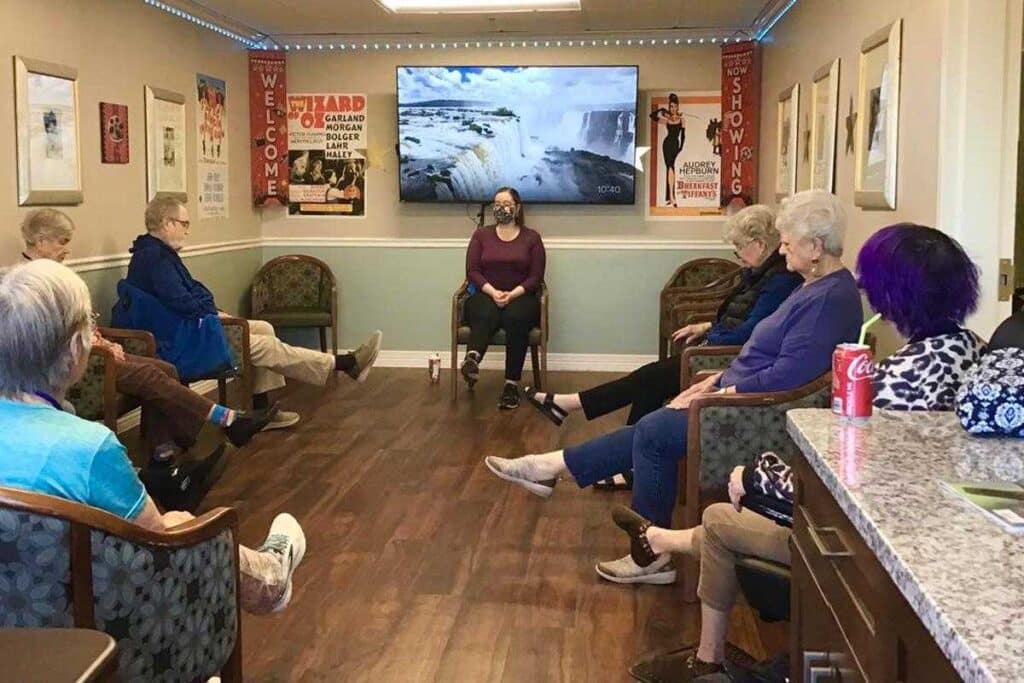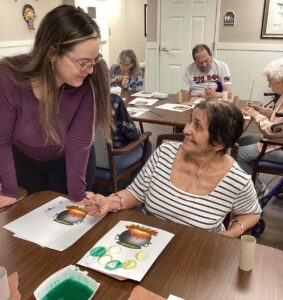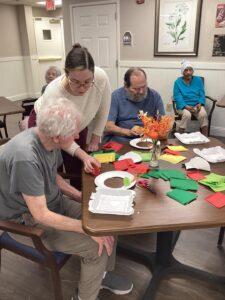
Physical therapy for seniors isn’t just about movement at Parmer Woods at North Austin. It’s about motivation, mindset, and meaningful relationships.
Jessica, the Director of Rehab with Powerback Therapy, comes to our assisted living and memory care community as a third-party provider and plays a key role in helping residents improve their health and quality of life while staying connected to the community around them.
How Jessica from Powerback Therapy Helps Residents Help Themselves at Parmer Woods at North Austin
For Jessica, providing therapy in assisted living revolves around a simple but powerful idea:
- Encouraging people to do things they may not want to do, but need to do for their well-being.
That requires trust, patience, and insight into why a resident hesitates.
Sometimes, it’s not that a person doesn’t want to engage — they might have:
- Depression
- Disconnection
- A risk of falling
- A limited range of motion
- Mobility issues or chronic pain
That’s why Jessica integrates social and emotional care into her therapy service sessions to reduce pain, increase muscle strength, and reduce the risk of avoidable health conditions.
For example, if a resident declines to attend an activity, Jessica often encourages what she calls a “drive-by” of the activity room as part of the therapy session.
The idea? She says, “Let’s just peek inside and see what they’re doing.” Once they’re near the activity room, she says, “Let’s do just one physical exercise with them. Just once.”
These small steps build comfort, familiarity, and eventually, participation in the benefits of physical therapy.

Therapy in Assisted Living: Social Engagement Drives Physical Health
Jessica understands the strong connection between physical and mental well-being. Older adults who engage socially are more likely to stay physically active, and vice versa.
That’s why she encourages walking to meals and attending activities — not just for movement, but to decrease the risk of:
- Anxiety
- Depression
- Cardiac events
- Cognitive decline
As she puts it, “the more activities you do, the healthier you are.”

Physical Therapy for Seniors Starts with Understanding the Person
Jessica says that physical therapy for senior living residents is not just physical — it’s psychological. Her role includes changing behaviors, building understanding, and ensuring each resident feels seen.
She uses a Vitality Check that screens for:
- Fall risk
- Functional arm strength
- Cognitive impairment and more
She spends about an hour with residents, asking what brought them to senior living and what they feel they need help with. This approach creates trust and validates their concerns.

Objective tools help confirm what residents often already suspect:
- They need to get out of their room
- Move more
- Connect with others
This screen also helps our teams and families better understand what level of support is needed. It can support transitions from assisted living to the Connections memory care program, based on evidence gathered from the cognitive screen, not guesswork.
Transparency and Education with Older Adults
Jessica loves patient education, but she also knows when it’s time to drop the formalities. Last month, she brought in coffee and donuts and held a casual “health chat” with residents. The conversation did not include charts or lectures. It was an honest, open talk about how people were feeling and how they could support their own wellness.
Jessica also takes pride in collaborating with residents’ family members to build transparency and educate them about senior rehab therapy, insurance, and senior living in general.
“You don’t know what you don’t know,” she often reminds people.
She also knows when to step back from families and residents. Sometimes they may need time to process that their physical and mental health are declining, and she wants to wait until they’re ready to talk to come up with a plan.
In one example, a resident was forgetting her walker and skipping activities. Rather than push further after initially broaching the topic, Jessica and the team waited for the resident and their family to come to her for help. Once they were ready, she said that based on the metrics, she recommended that the resident transition to memory care.
The resident moved to the Connections memory care program and participated in therapy focused on body awareness and daily movement. She also became more active and happier. Her family began receiving more phone calls from their mother, more engagement, and more peace of mind.
The Importance of Educating Our Team
Jessica’s role also includes staff education and collaboration. She supports training in activities of daily living (ADLs), safer transfers, body mechanics, and even how to communicate more effectively with residents in the Connections neighborhood.
She emphasizes clarity and patience for residents with cognitive impairments, especially when a resident is having trouble understanding or responding. She reminds the team:
- Say the person’s name
- Be direct
- Give them time to process

It may feel blunt at first, but it’s one of the best ways to help someone feel confident and successful.
She also partners with team members to teach them to be on the lookout for when a resident isn’t engaging in activities like crafts.
After observing a resident, she learned that one resident may need a better pen grip or fewer color choices (just two instead of five because more than two can feel overwhelming). Maybe they need help that hasn’t been identified yet.
Jessica looks for those clues and works with the team to bring in support where needed.
Personal Insight, Professional Experience
Jessica brings deep experience and compassion to her role through her clinical training and personal history. Her grandfather lived with Alzheimer’s for 12 years after an early diagnosis. Her grandmother had vascular dementia and remained stable for a long time before declining.

That lived experience, paired with a master’s in healthcare administration and expertise in physical therapy, gives Jessica a clear understanding of how to deliver value-based care that respects each resident’s dignity and potential.
Her ultimate message? Even small steps toward being more active, both physically and socially, make a huge difference. And the residents deserve to feel seen, understood, and supported in their health journeys.
Discover Senior Rehab Therapy in Austin, Texas
Parmer Woods at North Austin works with Jessica to provide various types of therapy to assisted living and memory care residents. We’re also excited about our partnership with SafelyYou to reduce fall-related injuries.
Contact us to learn more about senior living and the various benefits of our community in North Austin. Arrange a tour today.





